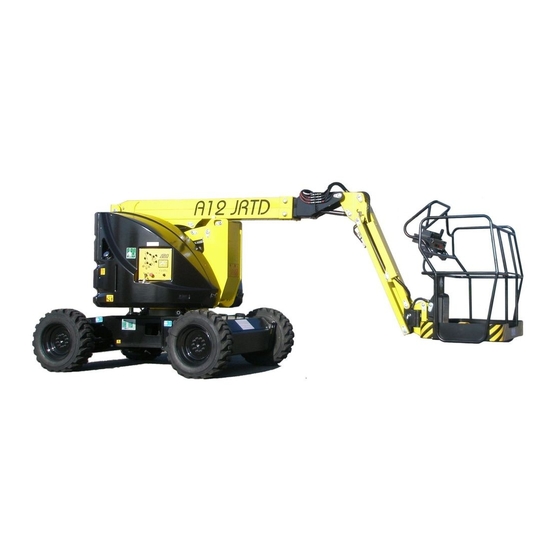
Table of Contents
Advertisement
Quick Links
PIATTAFORME AEREE SEMOVENTI
SELF-PROPELLED WORK-PLATFORMS
PLATES-FORMES DE TRAVAIL AUTOMOTRICES
SELBSTFAHRENDE HUBARBEITSBÜHNEN
PLATAFORMAS ELEVADORAS AUTOPROPULSADAS
ZELFRIJDENDE HOOGWERKERS
SJÄLVGÅENDE ARBETSPLATTFORMAR
SAMOKRETNE RADNE PLATFORME
"A" SERIES
A12 JRTD
A15 JRTD
USE AND MAINTENANCE MANUAL
- ENGLISH - ORIGINAL INSTRUCTIONS
AIRO is a division of TIGIEFFE SRL
Via Villa superiore, 82 - 42045 Luzzara (RE) ITALY-
+39-0522-977365 -
+39-0522-977015
WEB:
www.airo.com
057.20.UEM-EN
2020 - 12
Advertisement
Table of Contents

Summarization of Contents
1. INTRODUCTION
1.1. Legal aspects
Covers legal obligations, advice on machine use, commissioning, and ownership transfer.
1.2. Tests performed before delivery
Details tests conducted on MEWPs before market release, e.g., braking, overload, operating.
1.3. Intended use
Defines the machine's purpose for lifting persons/materials and specifies capacity limits.
1.4. Description of the machine
Outlines the machine's components: chassis, turret, articulated boom, and platform.
1.5. Control panels
Describes platform and turret control panels for normal use and emergency operations.
1.6. Power supply
States machine power source is Diesel heat engine; mentions hydraulic/wiring diagrams.
1.7. Machine life, demolition and decommissioning
Covers machine lifespan, inspections, and disposal procedures according to regulations.
1.8. Identification
Explains machine identification via serial number plate and chassis stamp for parts/service.
1.9. Location of main components
Illustrates and lists main machine components: control panel, engine, lifting cylinders.
2. TECHNICAL FEATURES OF STANDARD MACHINES
2.1. Model A12 JRTD
Provides dimensions, stability limits, and performance specifications for the A12 JRTD model.
2.2. Model A15 JRTD
Lists dimensions, stability limits, and performance specifications for the A15 JRTD model.
2.3. Vibrations and noise
Details noise levels (dB(A)) and vibration acceleration (m/sec²) for operator safety.
3. SAFETY PRECAUTIONS
3.1. Personal protective equipment (PPE)
Emphasizes mandatory PPE (hard hats, safety shoes) and safety harness use.
3.2. General safety norms
Outlines safe operation rules: age, user count, capacity, power line distance.
3.3. Use instructions
General guidelines: no system tampering, avoid adverse weather, proper handling.
3.4. Dangerous situations and/or accidents
Procedures for handling defects and accident response, including first aid and isolation.
4. INSTALLATION AND PRELIMINARY CHECKS
4.1. Becoming acquainted with the machine
Stresses need for updated operator training on machine differences.
4.2. Preliminary operation checks
Lists essential visual checks: battery, oil level, ground condition, controls integrity.
5. USE INSTRUCTIONS
5.1. Platform control panel
Details platform control panel operations, indicators, and warnings.
5.2. Ground control panel and electric control unit
Explains ground controls for start-up, emergency, and parameter monitoring.
5.3. Platform access
Describes safe access/egress procedures at the designated "access position".
5.4. Machine start-up
Step-by-step guide for starting the machine safely.
5.5. Machine stop
Procedures for normal and emergency machine/engine stops.
5.6. Emergency manual controls
Instructions for using manual controls during electric/hydraulic system failures.
5.7. Socket for electric tool connection (Optional)
Describes the optional tool connection socket and necessary power requirements.
5.8. Fuel level and re-fuelling (models “ED”, “D”)
Guides on checking and refuelling the diesel engine's fuel tank.
5.9. End of work
Procedures for safely shutting down the machine after use.
6. HANDLING AND CARRYING
6.1. Handling
Covers machine handling, turret lock, and driving with lifted/lowered platforms.
6.2. Transportation
Instructions for safe machine transportation, including loading and securing.
6.3. Emergency towing of the machine
Details standard and optional emergency towing procedures with safety and speed limits.
7. MAINTENANCE
7.1. Machine cleaning
Explains machine cleaning with non-pressurized water jets and protective measures.
7.2. General maintenance
Lists main maintenance tasks and frequencies, including checks and replacements.
7.2.1. Various adjustments
Details component checks and tightening procedures with torque specifications.
7.2.2. Greasing
Guidelines for greasing articulated joints and telescopic extensions with specific grease types.
7.2.3. Hydraulic circuit oil level check and change
Procedures for checking, topping up, and changing hydraulic oil, including oil types.
7.2.4. Hydraulic filter replacement
Instructions for replacing suction, return, and discharge filters with replacement frequency.
7.2.5. Telescopic boom sliding blocks clearance adjustment
Procedure for checking and adjusting telescopic boom sliding block clearance.
7.2.6. Circuit movements pressure relief valve operation check
Steps to check and calibrate pressure relief valves for proportional and ON-OFF movement circuits.
7.2.7. Operation check of the turret inclinometer
Procedure to check the turret inclinometer's function and its impact on machine operations.
7.2.8. Adjustment of the overload controller (load cell)
Explains the overload controller's function and procedures for checking its operation.
7.2.9. Overload controller by-pass – ONLY FOR EMERGENCY OPERATIONS
Details how to bypass the overload controller for emergency handling when a fault occurs.
7.2.10. Operation check of M1 microswitches
Describes the function of microswitches and how to check their operation annually.
7.2.11. Operation check of dead-man pedal safety system
Outlines the procedure for checking the dead-man pedal safety system for proper function.
7.3. Starter battery
Covers battery maintenance, charging, and replacement, emphasizing safety and manufacturer approval.





Need help?
Do you have a question about the A15 JRTD and is the answer not in the manual?
Questions and answers